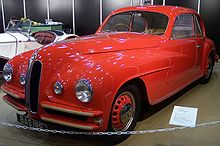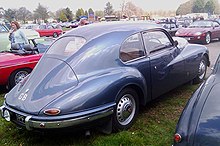Bristol 401
| Bristol | |
|---|---|
|
Bristol 401
|
|
| 401 | |
| Production period: | 1949-1952 |
| Class : | Upper class |
| Body versions : | Coupe |
| Engines: |
Otto engine : 2.0 liters (62.5 kW) |
| Length: | 4864 mm |
| Width: | 1702 mm |
| Height: | 1524 mm |
| Wheelbase : | 2898 mm |
| Empty weight : | |
| Previous model | Bristol 400 |
| successor | Bristol 403 |
The Bristol 401 was the second automobile of the Bristol Aircraft Company (later: Bristol Cars ), which was offered from 1948 next to the Bristol 400 presented two years earlier .
background
The Bristol Aircraft Company had launched their first automobile on the market in 1946, the Bristol 400, which was positioned in the upper class and received approval in the British press. In some export markets, however, the lack of space, especially in the area of the rear seats and in the trunk, was criticized, so that Bristol decided in early 1947 to develop a larger vehicle. However, since on the one hand the technical basis of the Bristol 400 and above all its six-cylinder engine were to be taken over unchanged and on the other hand the new car should not be slower than the 400 despite its larger dimensions, the company decided early on to use a lightweight construction that reduced the vehicle weight compared to the 400 ; In addition, the body should be particularly aerodynamic. To achieve these goals, Bristol developed the new model - the Bristol 401 - together with the Italian Carrozzeria Touring , which had special skills in the field of lightweight construction with its patented, Superleggera construction principle.
Development history
The Bristol 401 took over the chassis of the 400 unchanged. The drive technology including the motor did not experience any changes. Bristol used the 85C engine already known from the 400, which delivered 85 hp.
In contrast, the body was completely new. In contrast to its predecessor, it was made of aluminum and, following the Superleggera principle, rested on a frame made of steel tubes. The Bristol 401 was one of the first British cars to undergo extensive wind tunnel testing on a 1:10 scale model before production began. This resulted in a drag coefficient of 0.36. This made the 401 one of the most aerodynamically effective cars of its time. In the construction of the body, Bristol received support from the British specialist company The Abbey Panel & Sheet Metal Co. , which also built at least one prototype.
In terms of design, the body of the 401 was based on the Alfa Romeo 6C 2500 Coupé, also designed by Touring . The body design came mainly from Touring, but was revised in detail by Bristol designers. The bonnet tapered to a point, on both sides of the narrow radiator grille, which in the case of the Bristol still consisted of two “kidneys”, there were two round light units, and the fenders extended into the doors. The roof structure, however, was independent. It was very high up to the rear axle in order to allow the greatest possible headroom in the rear, and then fell into a large, rounded rear. In total, the Bristol 401 could adequately carry five adults.
The structure had some unusual detailed solutions. First of all, the bumpers were special. They were initially chrome-plated - later they were painted the same color as the car - and had rubber inserts to absorb light bumps. The taillights and turn signals were integrated into the bumpers. For aerodynamic reasons, there were no outer door handles. There were only push buttons on the doors, after which the door opened a crack, after which another mechanism had to be operated to open the doors completely. The spare wheel was in its own compartment under the trunk; it was accessible from the outside.
The performance of the Bristol 401 was rated as convincing by the press. The high manufacturing quality and the almost complete absence of wind noise even at high speeds have been repeatedly praised. The 401 reached a top speed of 98 miles per hour (about 155 km / h). Despite its larger dimensions, it surpassed the performance of the smaller Bristol 400. This was seen as proof of the success of efforts to achieve lightweight construction and aerodynamic efficiency.
The Bristol 401 was presented together with the Cabriolet version 402 at the London Motor Show in Earls Court in October 1948 . The production lasted from 1948 to 1952. The Bristol Owners Club tries to divide the production into three series, which differ in details from each other. Differentiation is made more difficult, however, by the fact that Bristol, as a typical small series manufacturer, more or less regularly changed, improved or simply adapted some details to customer requirements.
A total of around 650 copies of the Bristol 401 were made.
Special bodies
A modification of the 401 was the Bristol 402, a four-seater convertible that was only produced in a few copies. In addition, a number of other special bodies were created, most of which remained individual pieces or were only implemented in a few copies. They included:
- Four convertibles designed by Pininfarina and largely conforming to the design developed by the Italian bodywork for the Bristol 400.
- Two two-door coupés (saloons) with bodies by the Swiss body manufacturer Gebrüder Beutler from Thun .
- A convertible that the Beutler Brothers built for the 1951 Geneva Motor Show . The vehicle had pronounced front fenders that continued to the rear of the car. The car was offered at auction in Switzerland in 2007 but was not sold.
- Two or three Cabriolets (Drophead Coupés) with a body from Bradburn & Wedge, a Bristol dealer at the time.
- A two-door, almost four-seater saloon designed by Giovanni Michelotti in 1954 for the Lugano- based Carrozzeria Ghia-Aigle. The car was probably built in Switzerland. The vehicle had essentially a straight pontoon body with an indicated curve over the rear axle. The passenger compartment was set far back. The roof struts were made very narrow; the glass surfaces clearly predominated. The vehicle was delivered in light paint with a blue roof. In terms of proportions, the Ghia-Aigle structure anticipated the design of the later Bristol 406.
literature
Brand monographs
- RM Clarke: Bristol Cars: A Brooklands Portfolio: 132 Contemporary Articles Drawn from International Motoring Journals , UK 2001 (engl.)
- LJK Setright : A private car , 2 volumes, UK 1999 (engl.)
- LJK Setright: Bristol Cars and Engines , UK 1974, ISBN 978-0-900549-22-9 (English)
- NN: A German-English classic. The history of the Bristol brand . In: Classic Cars Spezial - English classic cars. June / July / August 1994, p. 6 ff.
Contemporary press reports on the Bristol 401
- The Bristol Type 401 . In: Motor from November 24, 1948
- West Country Specialties - 401 . In: Autocar of November 26, 1948
- Evolution of the "401" . In: Motor from July 19, 1950
Recent contributions to the Bristol 401
- Kevin Brazendale: The Encyclopedia of classic cars . Advanced Marketing Services, London 1999, ISBN 1-57145-182-X (English)
- David Lillywhite, Halwart Schrader: Classic Automobiles . Stuttgart (Motorbuch Verlag) 2005, ISBN 3-613-02552-3.
- Frank Oleski and Hartmut Lehbrink: Series sports cars . 1983/1993 (Könemann), ISBN 3-89508-000-4 .
- Dean Bachelor, Chris Poole, Graham Robson: The Big Book of Sports Cars ; Erlangen 1990 (no ISBN)
Web links
- Detailed description of the model history on the Bristol Owners Club website , accessed on August 11, 2010.
Individual evidence
- ^ The Bristol 401. Presentation and history of development in: Autocar from December 5, 1948.
- ^ Evolution of the "401" . Description of the wind tunnel tests with numerous illustrations. In: Motor from July 19, 1950.
- ↑ History of Abbey Panels on the website of the parent company Loades Plc (accessed on October 13, 2019).
- ↑ The Bristol Type 401 . In: Motorcar from November 24, 1938.
- ^ The Bristol 401. Motor Sport Road Test . In: Motor Sport, issue 1/1953.
- ^ The Bristol Type 401. Continental Road Test . In: Motor 1952.
- ↑ Model history on the Bristol Owners Club website.
- ↑ Bachelor, Poole, Robson: The great book of sports cars , p. 94. Likewise, Lillywhite, Schrader: Classic automobiles , p. 90.
- ↑ Detailed overview on the Bristol Owners Club website (no images).
- ↑ Brief description and illustration on the website www.thoroughbred-cars.com.
- ↑ Short model history on the website www.supercars.net (with images).
- ↑ Note on www.ghia-aigle.info
- ↑ Graphic illustration at Classic Cars Spezial - Englische Oldtimer, p. 11.
| Vehicle class | Body versions | 1940s | 1950s | 1960s | 1970s | 1980s | 1990s | 2000s | 2010s | 2020s | ||||||||||||||||||||||||||||||||||||||||||||||||||||||||||||||||||
| 6th | 7th | 8th | 9 | 0 | 1 | 2 | 3 | 4th | 5 | 6th | 7th | 8th | 9 | 0 | 1 | 2 | 3 | 4th | 5 | 6th | 7th | 8th | 9 | 0 | 1 | 2 | 3 | 4th | 5 | 6th | 7th | 8th | 9 | 0 | 1 | 2 | 3 | 4th | 5 | 6th | 7th | 8th | 9 | 0 | 1 | 2 | 3 | 4th | 5 | 6th | 7th | 8th | 9 | 0 | 1 | 2 | 3 | 4th | 5 | 6th | 7th | 8th | 9 | 0 | 1 | 2 | 3 | 4th | 5 | 6th | 7th | 8th | 9 | 0 | ||
| Upper class | limousine | 405 | ||||||||||||||||||||||||||||||||||||||||||||||||||||||||||||||||||||||||||
| Coupé / convertible | 400 | 403 | ||||||||||||||||||||||||||||||||||||||||||||||||||||||||||||||||||||||||||
| 401 | 405 | 406 | 407 | 408 | 409 | 410 | 411 | 603 | Brigand | Blenheim | ||||||||||||||||||||||||||||||||||||||||||||||||||||||||||||||||||
| 402 | Britannia | |||||||||||||||||||||||||||||||||||||||||||||||||||||||||||||||||||||||||||
| Sports car | Coupé / convertible / roadster | 404 | 406 Zagato | 412 | Beaufighter | Blenheim Speedster | Bullet | |||||||||||||||||||||||||||||||||||||||||||||||||||||||||||||||||||||
| Arnolt-Bristol | Fighter | |||||||||||||||||||||||||||||||||||||||||||||||||||||||||||||||||||||||||||
| race car | - | 450 | ||||||||||||||||||||||||||||||||||||||||||||||||||||||||||||||||||||||||||




